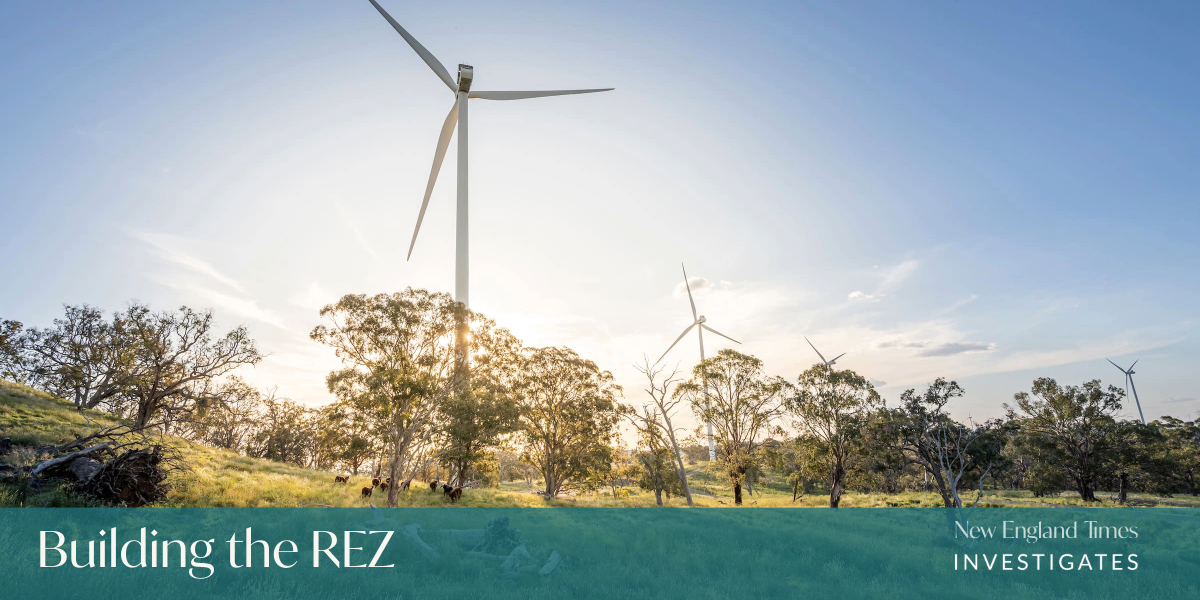This story is part of our feature series on Building the REZ in the New England.
Read more from this series here.
Landholders in NSW are set to reap the biggest economic benefit from the renewable energy shift according to a new report commissioned by Farmers for Climate Action (FCA).
The ‘Billions in the bush: Renewable energy for regional prosperity’ report predicts farmers and landholders in NSW will have received up to $3.4 billion in payments by 2050 from developers.
That compares to up to $3.3 billion for Queensland landholders, $1.7 billion in Victoria, $863 million in South Australia and $438 million in Tasmania. The figures are based on the ‘Optimal Development Pathway’ for the Australian Energy Market Operator’s StepChange scenario.
Farmers for Climate Action CEO, Natalie Collard, said clean energy was making farmland more productive.
“Hosting modern clean energy helps our farmers continue their traditions. Farmers that choose to host renewables are farming sheep and cattle around wind turbines and under solar panels, creating a double income from the land,” Ms Collard said.
“Farmers are being offered more than $40,000 per turbine per year and $1500 per hectare per year for solar.”
Not so great for the guy down the road
NSW Farmers Energy Transition Taskforce Chair Reg Kidd said the income benefits for farmers who voluntarily enter into an agreement to host a renewable project are a win-win, but those farmers being forced to have the associated transmission lines on their land are at a disadvantage.
“That is in part due to lack of engagement and consultation with the farming community. A lot of land is to be compulsorily acquired for transmission lines and the planning deficiencies in this area show that we have put the cart before the horse.”
“Yes, farmers can get some compensation for hosting transmission lines but that is only for 20 years and not for the life of the project like it is for hosting a wind or solar project. Having transmission lines also reduces land value.”
Mr Kidd said NSW Farmers is working with EnergyCo on a Mandatory Code of Conduct for the planning and construction of transmission projects that will focus protecting productive agricultural land.
“We are all for the renewable energy projects in the right place. When it comes to transmission lines, we should be seriously looking at undergrounding.
“Initial construction costs are higher, but over time undergrounding is cheaper option due to less maintenance and improved technology, and it’s not a scar on the landscape.
It would get rid of a lot of the opposition to transmission lines too, reducing the planning time and costs.”
Contributing to communities
Developer contributions to councils and communities will also be the highest in NSW, amounting to $715 million by 2050 according to the report, which was jointly produced by FCA and the Clean Energy Council.
The report highlighted Squadron Energy’s community co-investment scheme for its Sapphire Wind Farm near Glen Innes as an example.
“The program has had approximately $1.8 million in investments for a 10-year term since its launch in 2017, with contributions from local residents and participants from the ACT,” Squadron Energy Executive General Manager of Development, Alistair Smith said.
“It has been a win-win for the community and the environment, working with local investors to create a cleaner and more sustainable future for the country. Creating a lasting economic legacy for the regions in which we develop and operate renewable energy assets is just as important as the infrastructure itself.
The Pines Wind Farm near Oberon also featured for offering electricity bill credits to residents in the Oberon local government area. More than 2000 households are already eligible to receive credits of $100 per year, which will rise to $250 per year during the construction and operational phases.
Is there strong community support for REZs?
FCA also commissioned a survey of 1001 people living in 33 renewable energy zones across the country, including the New England REZ.
The survey found that 70 per cent of supported renewable energy projects on farmland with 17% opposing the combination. Key findings from the farmer focus groups in the survey revealed that 73% of those with a connection to farming also backed clean energy projects on local farmland.
There are conditions to that support, however, that include no disruption to farming activities, certainty on decommissioning and rehabilitating sites and no biodiversity impact.
Ms Collard said the results, which were released last week, matched that of a recent Porter Novelli regional poll, A CSIRO survey of 6000, Renewable Energy Zone polling by RE-Alliance, and even the results across the recent NSW council elections.
“The data shows the quiet majority of rural Australia is clearly in favour of clean energy projects locally, although many don’t realise they’re part of the quiet majority,” Ms Collard said.
“Those who don’t support clean energy and those who do have a lot in common – they express the same valid concerns.”
“Regional Australia is clearly asking the Government to hold developers to account as they aim to build clean energy projects. Those polled clearly ask for the Government to take charge on decommissioning.”
This story is supported by grant funding from the Local Independent News Association (LINA) and the Meta Australian News Fund administered by the Walkley Foundation.
Like what you’re reading? Support New England Times by making a small contribution today and help us keep delivering local news paywall-free. Support now


